Yet another bean recipe
But actually the Ghormeh Sabzi I mentioned last week because people asked. Both meaty and vegan options below. Plus a way of making a decent tahdig in the pressure cooker
So the mention of Yasmin Khan’s ghormeh sabzi the other day had me craving it, and then cooking it, and then deciding I should work out a vegetarian version too. Which I then realised was actually vegan, although if it is served with a traditionally buttery rice or with buttery flatbread (We gently fry flatbreads in butter in our house), then it is back to being vegetarian. I think the vegan option works simply just with the greens and beans, but to add more vegetal interest I made it with aubergines too.
I want to put in a caveat here that I am not pretending this is an authentic recipe. It is based loosely on Yasmin’s, but obviously the method is a bit different and I do mess around with the combination of greens I use. But 2 things are non negotiable as far as I am concerned. You need fenugreek in some form and you need dried limes. I used the lighter coloured ones, but you can use any sort. You also need to put some time into sauteeing the herbs. I’ve seen this done separately in a dry frying pan but I think keeping the washing up down and cooking with the onion is perfectly acceptable.
I’ve now made the meat version twice in the last week. And it has been eaten, variously, with flatbreads, over leftover black rice, piping hot on its own, with hot buttered toast, piled into thermoses for lunch (Adam took extra for a friend who was supposed to be fasting) and cold from the pan (that last one Shariq who seems to prefer his food cold).
Before I get started on the recipe, another word about the greens. You need a combination, including a base green to add bulk (there are arguments about this, some people say herbs only, but I love the texture of slow cooked spinach so any opportunity to add it) - this is usually spinach, but mustard greens, or chard (just the leaves, shredded, you can add finely chopped stems with the onion or use them for something else), or any other greens which collapse into a thick stew but won’t turn sulfurous when cooked down - so no cabbage or spring greens.
Then you need the aromatic herbs - usually a mixture of coriander and parsley, with fresh, frozen or dried fenugreek (methi) leaf. If you have a good International shop near you, they should have dried and frozen fenugreek.
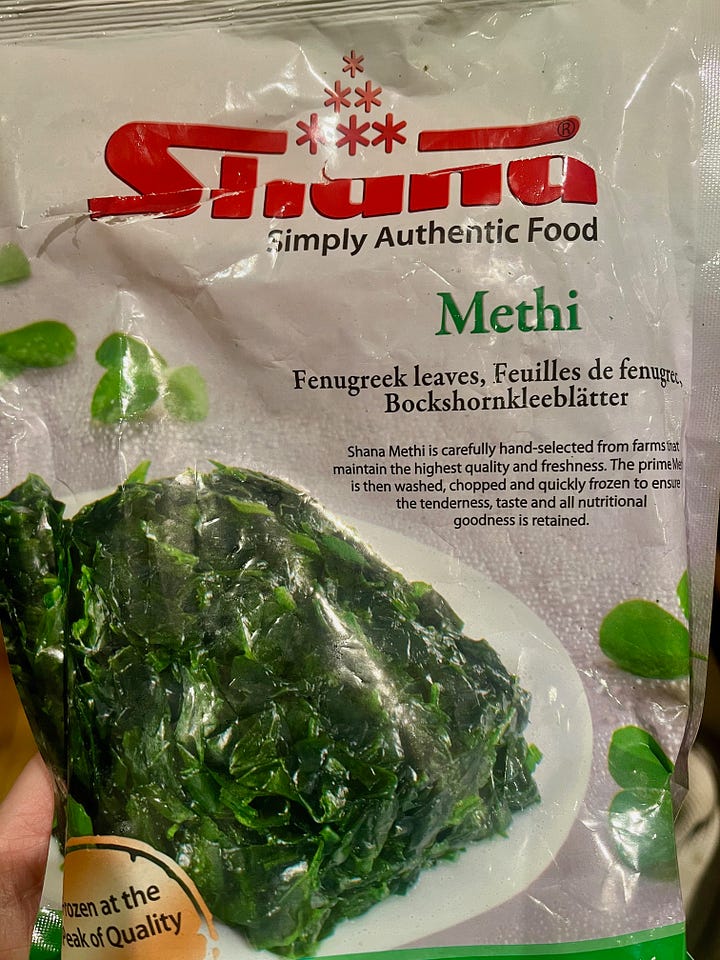
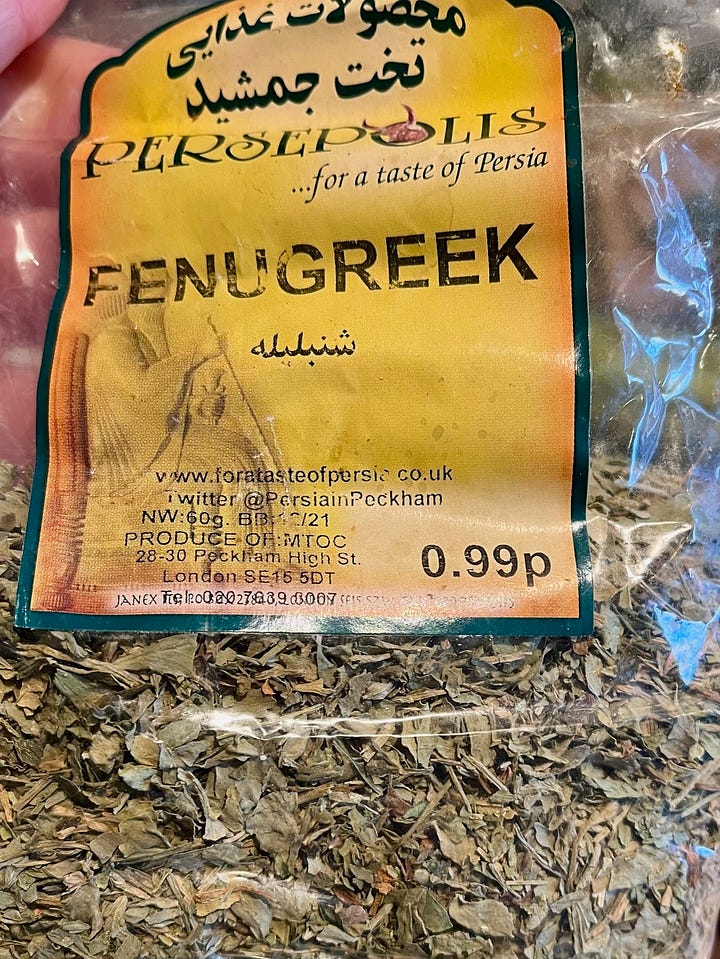
I find only the South Asian shops tend to have bunches of fresh - snap it up when you can, you can use it in all sorts of things. I like to cook it down with other greens in saag type dishes, or in the spinach and egg dish I’ve written about a couple of times, but also fried with potatoes or put into things like bubble and squeak.
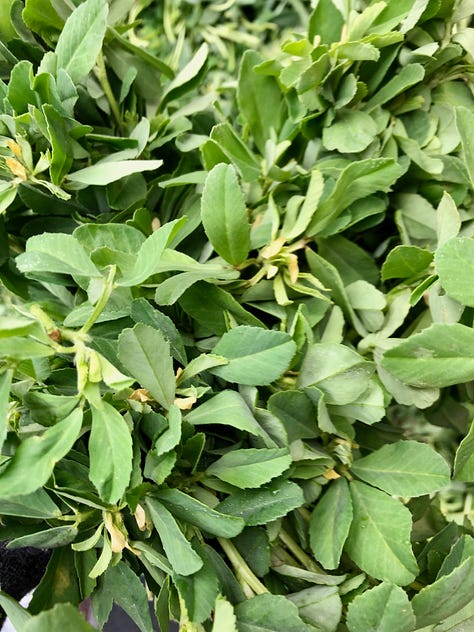
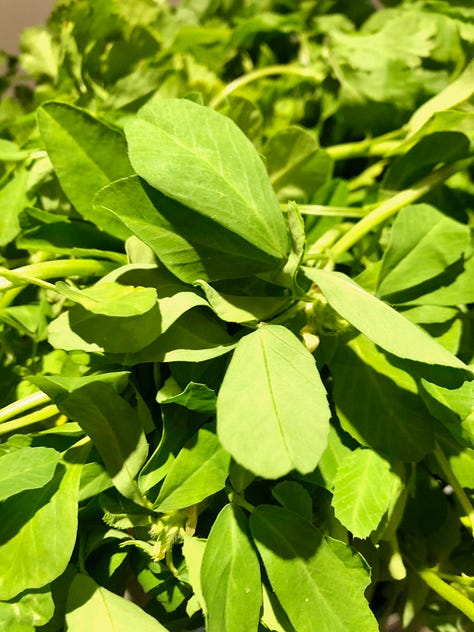
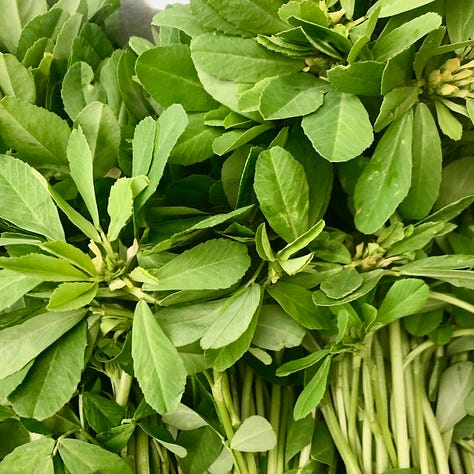
And check out the freezer cabinets as you never know what you will find. It is thanks to these discovery missions I realised you could buy frozen artichoke hearts which are much nicer than tinned and found packets of all kinds of greens I associate with Greek horta dishes, such as wild chicory. Today I found 2 different sabzi mixes which I tried in the aubergine version below, supplementing the fresh herbs.
The meat version
You should use lamb/mutton/goat/beef for this - I think the cut is more important than the type of meat. My preference is for mutton and I use a mixture of on and off the bone - a little fat, not too much, but with a couple of pieces cut across the bone so you get the marrow (Shariq’s favourite). These look like the middle of the shank - in fact shank is an ideal cut as it is isn’t too fatty, but fatty enough to give the stew the right texture. Or use a combination of a couple of pieces of on the bone neck or chops with some diced meat.
2 tbsp olive oil
1kg lamb/mutton/goat/beef in chunks on/off the bone
2 red onions, finely chopped
4 cloves garlic, finely chopped
1 large bunch coriander, finely chopped
1 large bunch parsley, finely chopped
2 tbsp dried fenugreek leaf OR 100g frozen fenugreek or leaves from a bunch of fenugreek (all optional, but the flavour is very distinctive so add if you can)
2 spring onions, very finely chopped (include the green tops)
1 tsp turmeric
1 tsp ground fenugreek (optional, the seed this time, use if you can’t get the greens)
1/2 tsp cinnamon
400g frozen spinach, preferably whole leaf
250g dried beans, soaked or quick soaked, OR 500g cooked. Around 500ml water
4 dried limes, pierced with a fork
Heat your pressure cooker and add the oil. Add the lamb and sear on both sides then remove.
Add the onion and saute for a few minutes, then add the garlic. Reserve around a quarter of the herbs, then stir them in too, along with the spring onions. Continue to saute for another 3-4 minutes - the herbs should start smelling very aromatic, this is often considered the most important part of the whole dish - then stir in the spices.
Return the lamb to the pan, add the beans and pour in 500ml water. This should be enough to cover the lamb and the beans. Drop in the blocks of spinach and push in the limes - they may be buoyant so let them fill with liquid until they submerge. Season generously with salt and pepper.
Make sure the base of the cooker is deglazed, then put on the lid. Bring up to high pressure then adjust the heat so it is just high enough to maintain the pressure. Cook for 20 minutes, then remove from the heat and leave to drop pressure naturally.
Taste for seasoning and adjust as necessary. Stir to break up the clumps of spinach, then add the reserved herbs and plenty of lemon juice. Push the limes against the side of the pressure cooker to get rid of any trapped liquid, then remove.
Serve in shallow bowls with flatbreads or the rice dish below.
For the Vegan Version
Because the aubergines don’t need so much cooking, it is better to make this with cooked beans instead of soaked. If you really want to use soaked but uncooked beans, you can fry the aubergines to get some colour, cook the stew as above but for just 15 minutes, then add the aubergines back and cook for 2 minutes HP. Fast release is fine in this instance.
But - if using cooked beans, follow the above recipe, but substitute the lamb for 3 aubergines, diced. Make sure you brown the aubergines well - do this in more than one batch if necessary. You may need to use more oil. As they can stick, it is very important to heat your pressure cooker first to make the stainless steel base as non stick as possible.
Use 500-600g cooked beans and reduce the amount of liquid to 200ml.
Cook at high pressure for 3 minutes, natural release. Then add the herbs/lemon juice again as above.
You may need to reduce it down a bit more - I did with the one you can see below, after I took this photo. It very much depends on how much water comes out of the aubergines - if they are very fat and spongy, they will benefit from salting in a colander for half an hour and patting dry before you fry them.
And for a side dish -
Rice with Tahdig
This is one of those recipes which works best if you use either baking parchment or Bake-o-Glide. It will sit on the base of the cooker and stop the rice from burning. It isn’t essential (and unnecessary if your cooker is non stick) but does make like a bit easier.
There is a little trial and error here, working out exactly how long it will take for a golden crust to form. You can either take off a little corner to see how it is doing, but the best way to tell is by aroma – if it is smelling nutty and delicious, it should be just about there – just watch out for a whiff of burnt rice, as you will then know it has gone too far.
1 tsp olive oil
500g basmati rice, very well rinsed
75ml butter, melted
A large pinch of saffron, soaked in 2 tbsp warm water
Heat your pressure cooker, then swirl the oil over the base. This will help the parchment/Bake O Glide stay in place if using it, and adds a bit of extra protection for the rice if not. Add the parchment/Bake O Glide, then sprinkle over the rice. Give the cooker a very gently shake just so the rice falls into an even layer. Pour over 750ml water and season generously with salt. Make sure all the rice is sitting below the water and not clinging to the sides of the cooker.
Close the lid and bring up to high pressure. Adjust the heat so it is just high enough to maintain the presure, then cook for 3 minutes. Remove from the heat and leave to drop pressure naturally. In the meantime melt the butter and mix with the saffron and its soaking water.
Remove the lid from the pressure cooker. Using a wooden spoon handle, poke holes into the rice then fill with the saffron flavoured butter. Cover the cooker with a tea towel and place the lid loosely on top. Leave on a low heat (use the lowest saute function if using an electric pressure cooker) for around 10-15 minutes, then carefully loosen the rice round the edges and turn out onto a plate. Peel off the parchment if using and hopefully uncover a beautiful golden layer of crusty rice underneath. The top should be fluffy - every grain separate - and buttery and rich with saffron. And it works really well with the ghormeh sabzi.
If you want to make the ghormeh sabzi and the rice and you have just the one cooker, I would recommend making the stew first and keeping warm in a casserole - or even better - make a day ahead. The meat version especially tastes better the next day.
I am escaping for a couple of days tomorrow - down to the Dorset coast, hopefully back at my kitchen table on Friday. If you have enjoyed this post, please remember to click through on the heart, and share with anyone you think might like it. Thank you!


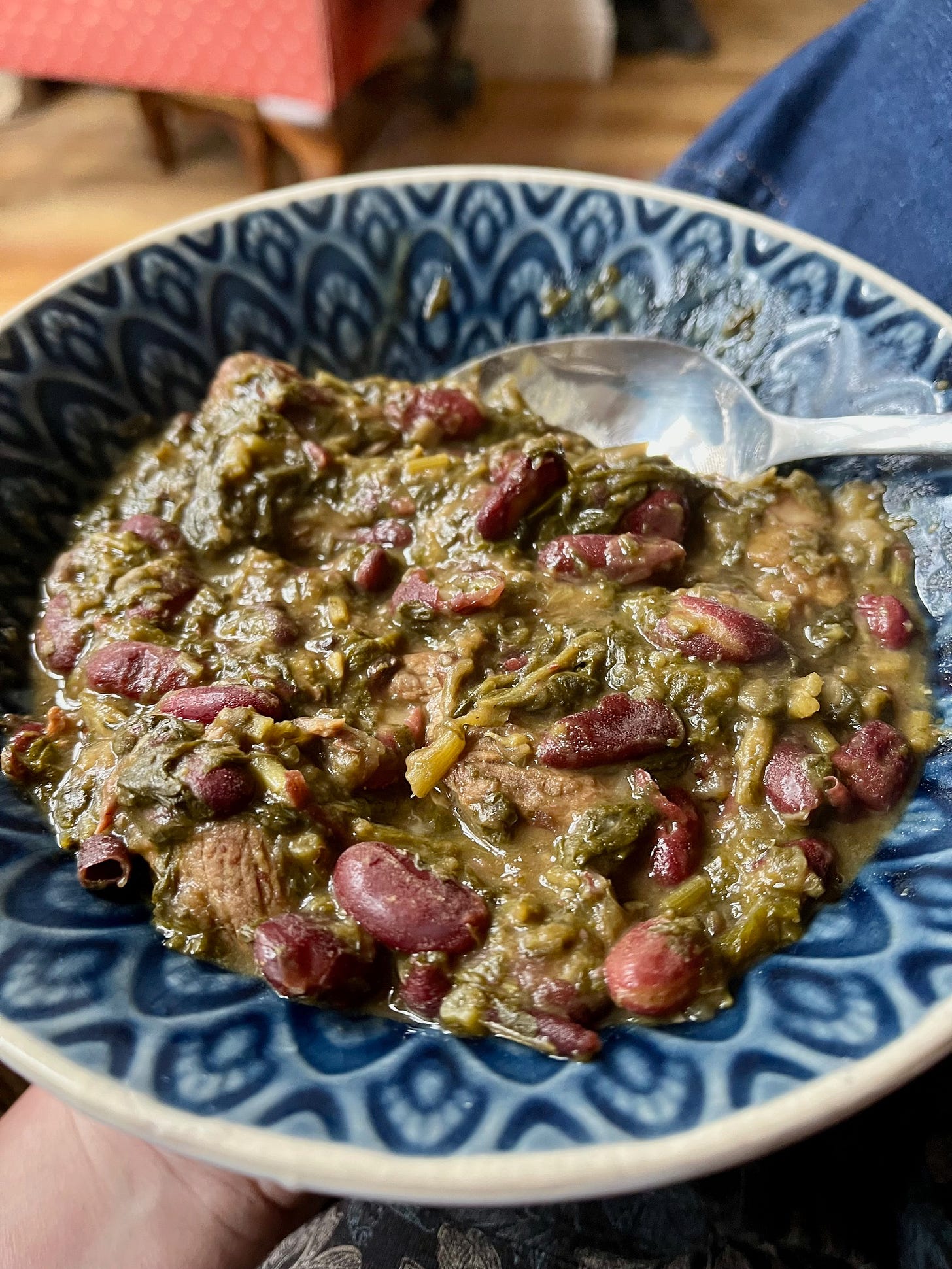


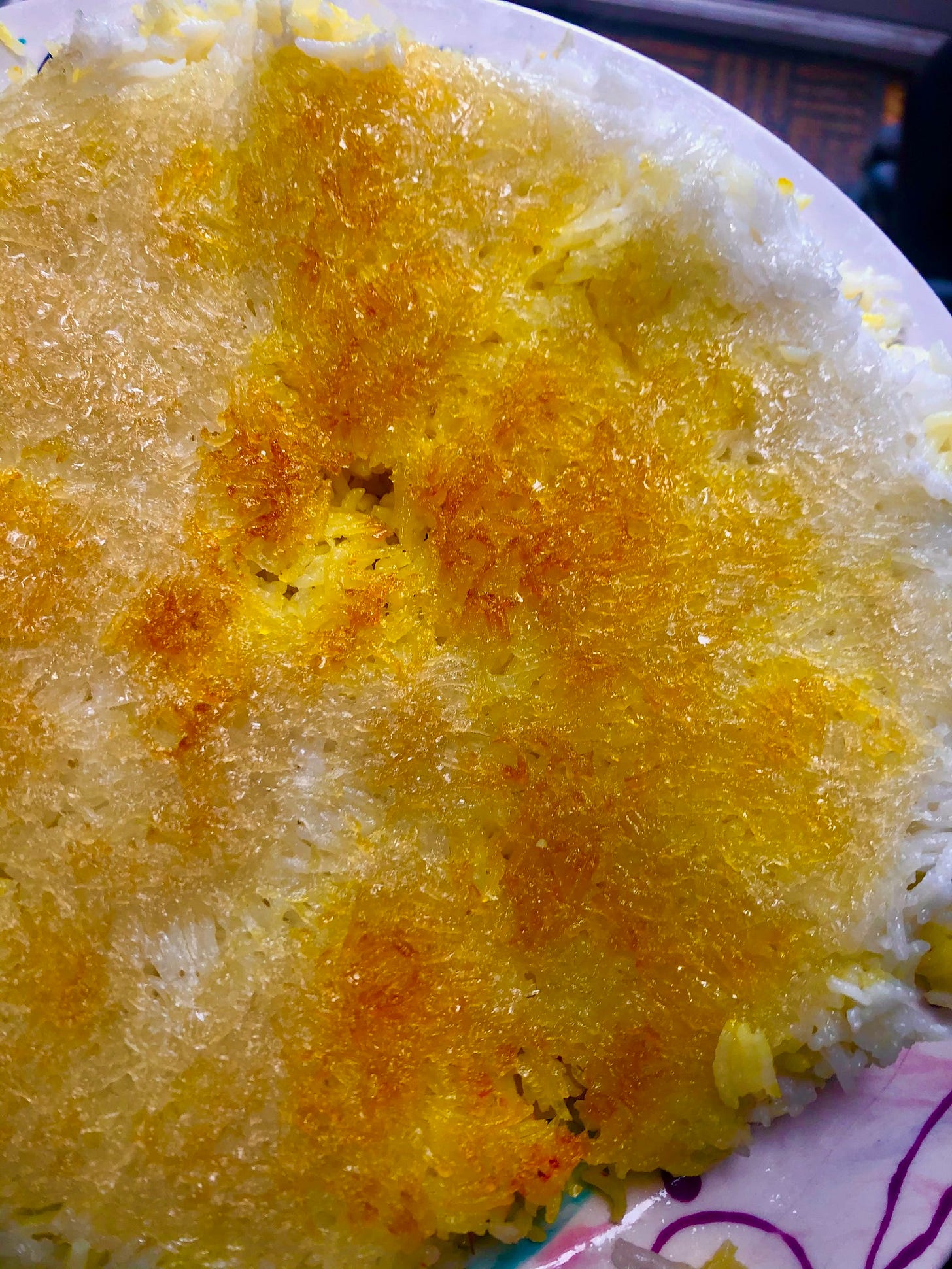
Another thought re herbs. Bee Wilson has an amazing recipe for a Persian style soup with herbs, and she suggests cooking the onions and herbs as step 1 in the InstantPot, and then adding beans etc and cooking in step 2. Now I understand why!
Interesting to read about sauteing the herbs being important. I suppose it deepens the flavour into a lower richer note (compared to the high notes of fresh coriander and parsley). And here's a good reason to follow the recipe as written - to learn something new :). I realised this when recipe testing a wonderful book called Istanbul and Beyond. Thanks for the reminder.